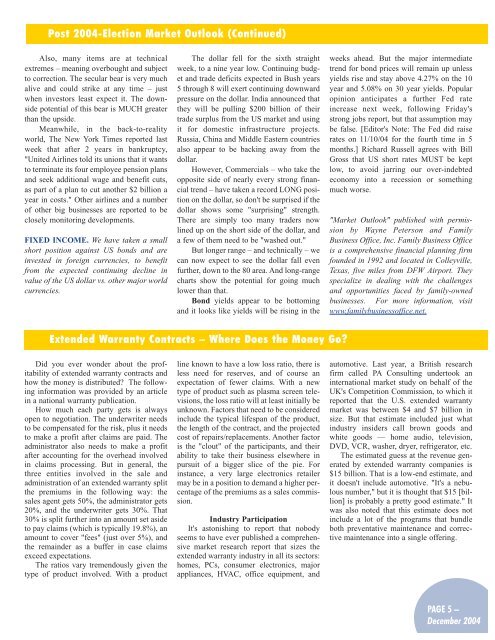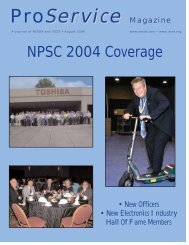December - International Society of Certified Electronics Technicians
December - International Society of Certified Electronics Technicians
December - International Society of Certified Electronics Technicians
You also want an ePaper? Increase the reach of your titles
YUMPU automatically turns print PDFs into web optimized ePapers that Google loves.
Post 2004-Election Market Outlook (Continued)<br />
Also, many items are at technical<br />
extremes – meaning overbought and subject<br />
to correction. The secular bear is very much<br />
alive and could strike at any time – just<br />
when investors least expect it. The downside<br />
potential <strong>of</strong> this bear is MUCH greater<br />
than the upside.<br />
Meanwhile, in the back-to-reality<br />
world, The New York Times reported last<br />
week that after 2 years in bankruptcy,<br />
"United Airlines told its unions that it wants<br />
to terminate its four employee pension plans<br />
and seek additional wage and benefit cuts,<br />
as part <strong>of</strong> a plan to cut another $2 billion a<br />
year in costs." Other airlines and a number<br />
<strong>of</strong> other big businesses are reported to be<br />
closely monitoring developments.<br />
FIXED INCOME. We have taken a small<br />
short position against US bonds and are<br />
invested in foreign currencies, to benefit<br />
from the expected continuing decline in<br />
value <strong>of</strong> the US dollar vs. other major world<br />
currencies.<br />
The dollar fell for the sixth straight<br />
week, to a nine year low. Continuing budget<br />
and trade deficits expected in Bush years<br />
5 through 8 will exert continuing downward<br />
pressure on the dollar. India announced that<br />
they will be pulling $200 billion <strong>of</strong> their<br />
trade surplus from the US market and using<br />
it for domestic infrastructure projects.<br />
Russia, China and Middle Eastern countries<br />
also appear to be backing away from the<br />
dollar.<br />
However, Commercials – who take the<br />
opposite side <strong>of</strong> nearly every strong financial<br />
trend – have taken a record LONG position<br />
on the dollar, so don't be surprised if the<br />
dollar shows some "surprising" strength.<br />
There are simply too many traders now<br />
lined up on the short side <strong>of</strong> the dollar, and<br />
a few <strong>of</strong> them need to be "washed out."<br />
But longer range – and technically – we<br />
can now expect to see the dollar fall even<br />
further, down to the 80 area. And long-range<br />
charts show the potential for going much<br />
lower than that.<br />
Bond yields appear to be bottoming<br />
and it looks like yields will be rising in the<br />
Extended Warranty Contracts – Where Does the Money Go?<br />
Did you ever wonder about the pr<strong>of</strong>itability<br />
<strong>of</strong> extended warranty contracts and<br />
how the money is distributed? The following<br />
information was provided by an article<br />
in a national warranty publication.<br />
How much each party gets is always<br />
open to negotiation. The underwriter needs<br />
to be compensated for the risk, plus it needs<br />
to make a pr<strong>of</strong>it after claims are paid. The<br />
administrator also needs to make a pr<strong>of</strong>it<br />
after accounting for the overhead involved<br />
in claims processing. But in general, the<br />
three entities involved in the sale and<br />
administration <strong>of</strong> an extended warranty split<br />
the premiums in the following way: the<br />
sales agent gets 50%, the administrator gets<br />
20%, and the underwriter gets 30%. That<br />
30% is split further into an amount set aside<br />
to pay claims (which is typically 19.8%), an<br />
amount to cover "fees" (just over 5%), and<br />
the remainder as a buffer in case claims<br />
exceed expectations.<br />
The ratios vary tremendously given the<br />
type <strong>of</strong> product involved. With a product<br />
line known to have a low loss ratio, there is<br />
less need for reserves, and <strong>of</strong> course an<br />
expectation <strong>of</strong> fewer claims. With a new<br />
type <strong>of</strong> product such as plasma screen televisions,<br />
the loss ratio will at least initially be<br />
unknown. Factors that need to be considered<br />
include the typical lifespan <strong>of</strong> the product,<br />
the length <strong>of</strong> the contract, and the projected<br />
cost <strong>of</strong> repairs/replacements. Another factor<br />
is the "clout" <strong>of</strong> the participants, and their<br />
ability to take their business elsewhere in<br />
pursuit <strong>of</strong> a bigger slice <strong>of</strong> the pie. For<br />
instance, a very large electronics retailer<br />
may be in a position to demand a higher percentage<br />
<strong>of</strong> the premiums as a sales commission.<br />
Industry Participation<br />
It's astonishing to report that nobody<br />
seems to have ever published a comprehensive<br />
market research report that sizes the<br />
extended warranty industry in all its sectors:<br />
homes, PCs, consumer electronics, major<br />
appliances, HVAC, <strong>of</strong>fice equipment, and<br />
weeks ahead. But the major intermediate<br />
trend for bond prices will remain up unless<br />
yields rise and stay above 4.27% on the 10<br />
year and 5.08% on 30 year yields. Popular<br />
opinion anticipates a further Fed rate<br />
increase next week, following Friday's<br />
strong jobs report, but that assumption may<br />
be false. [Editor's Note: The Fed did raise<br />
rates on 11/10/04 for the fourth time in 5<br />
months.] Richard Russell agrees with Bill<br />
Gross that US short rates MUST be kept<br />
low, to avoid jarring our over-indebted<br />
economy into a recession or something<br />
much worse.<br />
"Market Outlook" published with permission<br />
by Wayne Peterson and Family<br />
Business Office, Inc. Family Business Office<br />
is a comprehensive financial planning firm<br />
founded in 1992 and located in Colleyville,<br />
Texas, five miles from DFW Airport. They<br />
specialize in dealing with the challenges<br />
and opportunities faced by family-owned<br />
businesses. For more information, visit<br />
www.familybusiness<strong>of</strong>fice.net.<br />
automotive. Last year, a British research<br />
firm called PA Consulting undertook an<br />
international market study on behalf <strong>of</strong> the<br />
UK's Competition Commission, to which it<br />
reported that the U.S. extended warranty<br />
market was between $4 and $7 billion in<br />
size. But that estimate included just what<br />
industry insiders call brown goods and<br />
white goods — home audio, television,<br />
DVD, VCR, washer, dryer, refrigerator, etc.<br />
The estimated guess at the revenue generated<br />
by extended warranty companies is<br />
$15 billion. That is a low-end estimate, and<br />
it doesn't include automotive. "It's a nebulous<br />
number," but it is thought that $15 [billion]<br />
is probably a pretty good estimate." It<br />
was also noted that this estimate does not<br />
include a lot <strong>of</strong> the programs that bundle<br />
both preventative maintenance and corrective<br />
maintenance into a single <strong>of</strong>fering.<br />
PAGE 5 –<br />
<strong>December</strong> 2004




